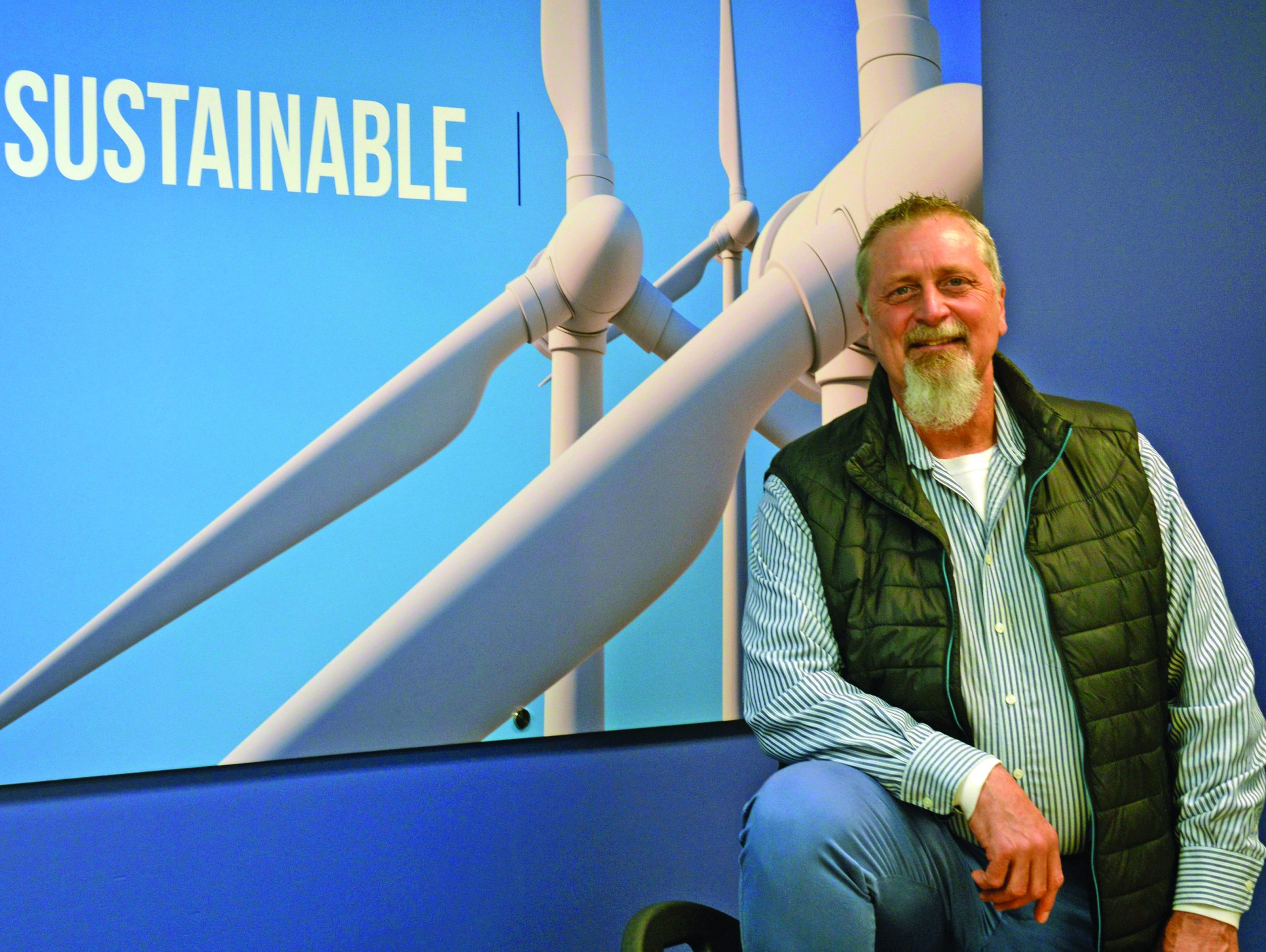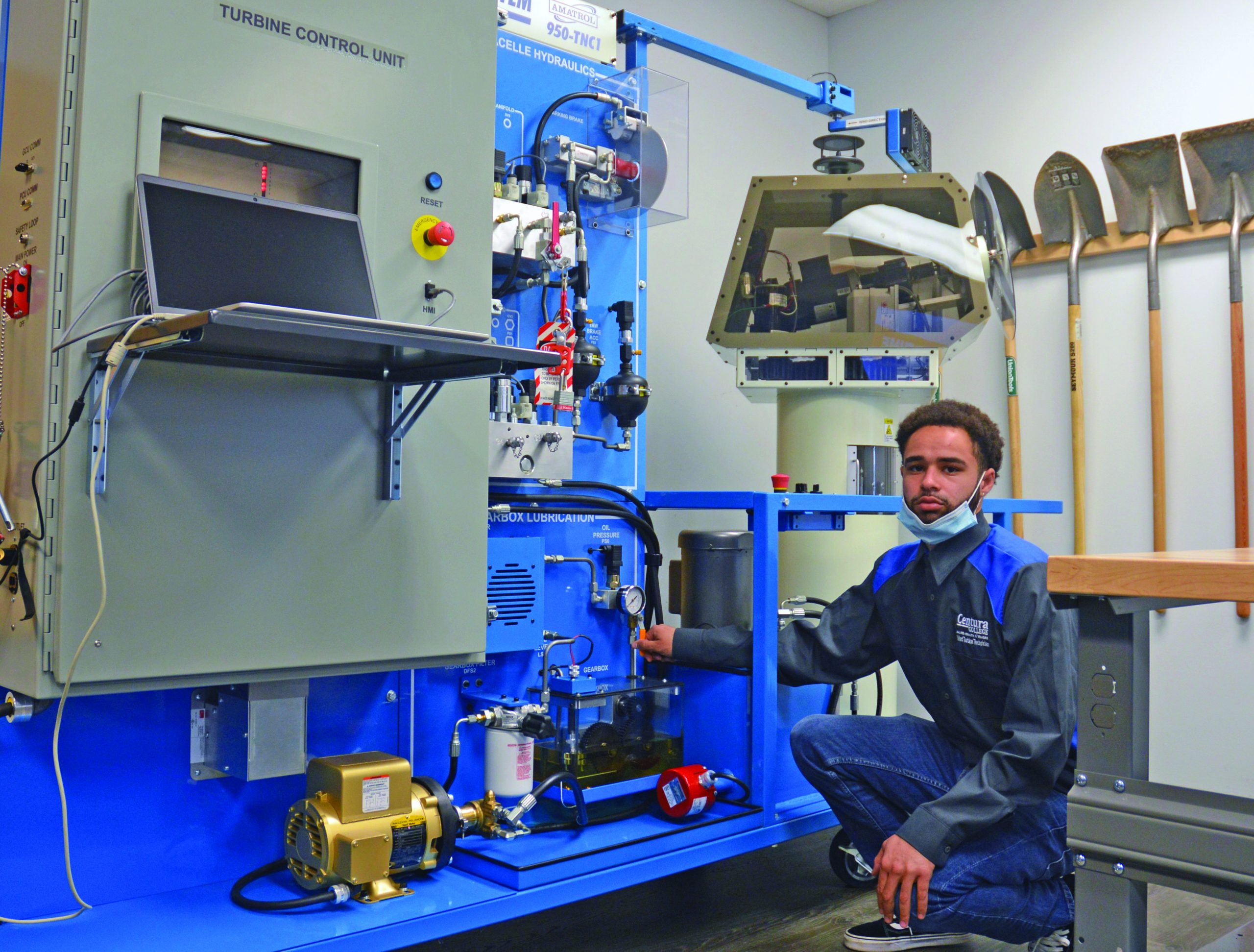Alan Glore’s decision to enroll in the business management program at the Centura College of Allied Health and Trades campus around the corner from his house in Newport News seemed like a logical career move.
After all, Glore reasoned, the commute was short, he would be crowning his associate’s degree in social services with a bachelor’s, and the former cellphone tower repairman would be keeping his feet on the ground, albeit reluctantly.
Then he spied a brochure in the for-profit college’s lobby. It beckoned students to explore a career in maintaining wind turbines.
 Glore was smitten enough to reinvent his future on the spot.
Glore was smitten enough to reinvent his future on the spot.
“Any job I’ve had since climbing cellphone towers hasn’t really done it for me,” he said. “I need to be up in the air.”
Now, the 39-year-old is on his way back up. In February, he joined the inaugural class of six intent on becoming certified wind-turbine technicians a year from now.
“I’d heard about it, but didn’t know how to be part of it,” he said about renewable energy work. “This is my jumpstart, with an exclamation point.”
With more than 5 GW of wind power literally on its horizon, the first-of-its-kind training is a piece of Virginia’s endeavor to become an industry hub. Students learn classroom and hands-on lessons at the Centura campus in Norfolk and two of its for-profit “sister” colleges — Tidewater Tech and the Aviation Institute of Maintenance.
Glore can barely contain his enthusiasm for discovering his academic groove. Even an untrained observer can detect a smile behind the redhead’s mask during an evening class in electricity.
It doesn’t matter that his round-trip commute, which includes navigating the oft-congested Elizabeth River tunnel, was lengthened to 60 miles, that he bagged his idea of starting a catering company with the planned business degree, or that certification requires 12 intense months of immersion.
“I better be exuberant about it because I’m already in it, and there’s no turning back,” Glore said. “I just feel I would’ve been treading water doing anything else.”
Oceanographer grabs wind, runs with it
That Glore was even able to pivot to a close-to-home degree related to renewable energy is due to the persistence — and impatience — of Michael Lanouette.
The oceanographer, with a doctorate in education, has dedicated 35 years to helping technical career colleges from Florida to California be nimbler and more relevant. Since a 2018 move to Virginia, he has focused on Centura and the associated for-profit campuses where he serves as vice president of administration.

“Wind is going to happen,” Lanouette said, his words tumbling as rapidly as he skittered among an impressive array of 100 welding booths tucked inside a Tidewater Tech building. “My question was: Are there going to be high-paying jobs available to graduates? The answer is yes, so we did it.”
“It” refers to innovating a wind-turbine technician program in nine months by adding specialized courses to the foundational ones already offered to aspiring tradespeople.
As a for-profit force, Lanouette said he was able to take a get-out-of-my-way approach and cut through bureaucratic red tape.
“I have a team, but I was the tip of the sword,” he said about his pluckiness. “We’re the muscle behind this.”
Since arriving in Virginia, Lanouette had attended meetings about how the state could fill thousands of anticipated wind jobs. Public universities such as Old Dominion, Virginia Tech, and James Madison covered the engineering and policy bases, but hemmed and hawed on the subject of turbine maintenance.
A frustrated Lanouette leaped to fill that void because “we’re the little engine that can. We can create niche programs that other schools can’t.”
That’s why he was beaming on February 3 when Democratic Gov. Ralph Northam and a slew of dignitaries attended a ribbon-cutting at Centura Norfolk for the program rollout.

And Lanouette was still smiling in mid-February when U.S. Sen. Mark Warner, D-Va., hosted a socially distanced conversation at the same campus with a who’s who of renewable energy insiders about how the state can position itself as an offshore wind leader.
Northam and a Democratic-majority General Assembly have been aggressive with legislation forcing the state’s main investor-owned utilities — Dominion and Appalachian Power — to displace fossil fuels with renewable energy.
Last October, when Lanouette was in the midst of weaving together his training program, the governor told a national audience about the new Mid-Atlantic Wind Training Alliance. In addition to Centura, Virginia’s nascent but bold attempt to create wind-specific jobs includes the New College Institute and the Mid-Atlantic Maritime Academy.
To ensure the courses have the wind industry’s seal of approval, all are certified by the Global Wind Organization and the National Center for Construction, Education, and Research.
Mayor Kenneth Alexander, in his fifth year leading Norfolk, is thrilled his hometown city is in the thick of training for a transition to clean energy. As chancellor of the three for-profit colleges, he is one of Lanouette’s top cheerleaders.
“Research and development is fine, but I wanted us to be part of the hands-on experience,” he said. “My passion is putting people to work.”

Location and a robust maritime history position southeast Virginia as the nexus where the economy, the workforce, and the supply chain can become wind-energy-centric.
Alexander and Lanouette have teamed up to “spread the gospel” educating people about real and viable job opportunities in renewable energy.
“Our little school had other groups talking with one another,” Alexander said. “We’re going to mean something in this field.”
The mayor is also motivated by the double-whammy jeopardizing the expansive Hampton Roads region on the Chesapeake Bay. An unfortunate and well-documented mix of geology and climate change means flooding is constant because the land is sinking as the ocean is rising.
“I didn’t just wake up one day to say I wanted to align myself with wind, solar, and energy storage,” said Alexander, a state legislator for 14 years. “It’s part of my body of work.”
‘I picked the right one’
Lanouette’s team hired two seasoned instructors — John Blumenstein and Trent Nylander — so Glore and his fellow trainees could absorb lessons from pros with years of on-the-job and teaching experience.
Nylander, a Colorado native and longtime electrician, entered the wind industry two decades ago as a technician. He worked in Colorado, Kansas, and Texas before landing in Norfolk.
“I always wanted to be near the beach, but I never thought it would be on the East Coast,” he joked. “Really though, this is an ideal situation because I love teaching.”

He feels confident his students will find jobs because the “market for wind is so hot right now that the industry can’t find enough bodies to fill positions.”
Blumenstein said the wind industry will reward those with knowledge who show extra effort. He learned that working for General Electric’s wind subsidiary after the company sent him to school in upstate New York in 2008.
Turbines were a natural segue for the Navy veteran with 45 years of experience as an auto mechanic.
“It’s basically the same,” he said, comparing what’s under the “hood” of each. “But with turbines, everything is bigger.”
Hired as the wind-turbine coordinator, Blumenstein embraces mentoring by easing Centura’s eager class of recent high school graduates, military veterans, and career-switchers into new roles.
“It’s exciting, especially when you think about the number of turbines going up just between here and Maryland,” he said. “It’s a great opportunity.”
Chance Payton of Virginia Beach is one of his student sponges keen to absorb every ounce of insight.
The soft-spoken 20-year-old, highlighter poised over his textbook on the table in a Centura classroom, admits he signed up after his mother demanded he select a career from a list of choices she drew up. In his heart, the recent high school graduate is aware she “nagged” him because she didn’t want her son settling for his job at the local carwash.
“I feel like I picked the right one,” Payton said about his mother’s tally, which also included carpenter, painter, mechanic, and nurse.
He was exposed to the principles of renewable energy during science classes at Wilson High School, where he gravitated to projects that dug into its related technology.
However, even though he excels at science and math, he admits being a bit intimidated by an entirely new vocabulary of nacelles, rotor blades, and gearboxes. He is still training his brain to soak in a new language.

Theory to practice
The squat unmemorable buildings that house Centura and Tidewater Tech are as nondescript as the different but equally dreary thoroughfares they are located along.
But the colleges weren’t invented to win architectural accolades. While some for-profit colleges have been under a harsh spotlight for questionable practices, these particular institutions provide the setting, instructors, and tools for students to gain command of a trade from theory to practice.
“That’s our wheelhouse,” Lanouette said. “It’s where we shine.”
Early on, Payton, Glore, and their fellow trainees were poring over the intricacies of safety, voltage, pneumatics, hydraulics, and electrical and mechanical systems. An interactive model of a turbine’s innards at the back of the classroom turns what they read and hear into three-dimensional exercises.
The practice part begins later. For instance, at the Aviation Institute’s composite lab, they will learn how to repair a damaged turbine blade, applying the same science used in the airline industry.
Live lessons in climbing, rigging, and rescue will start as soon as another partner, the nearby Mid-Atlantic Maritime Academy, delivers a 60-foot turbine to a now-empty lot adjacent to Centura.
Students will travel to the academy to practice rappelling, necessary because turbine blades are often close to 350 feet long, and maneuvering safely between a transport boat and a turbine.
If and when Hampton Roads attracts wind-turbine manufacturers — most fabrication is now in Europe — Lanouette is already brainstorming a future training program with Tidewater Tech’s 100 welding booths as its centerpiece.
He’s tuned in to what he calls wind energy’s “cool factor,” but what sparked him to initiate the technician program is far from superficial.
Lanouette formed a deep connection to the cycles of the sea during his oceanography studies. Plus, like any offshore wind technician, he knows what it’s like to live remotely in cramped quarters with little human contact and be a self-sufficient problem-solver.
“Our planet is fascinating in that it does have the ability to right itself,” he said. “It’s just that the humans can’t keep doing what we’re doing when it comes to pollution.”

Thinking beyond two wind farms
The technician program is on a rolling admission schedule. Already, a total of 10 more students are in line to start in April and May. That aligns with Centura’s motto of “get in, get out, and get a good job.”
Lanouette knows it was a gamble to graduate the first classes in 2022, three years before Dominion Energy will complete its 188-turbine, 2.6-GW Coastal Virginia Offshore Wind commercial project 27 miles off the coast of Virginia Beach.
But somebody had to plant the proverbial flag.
Jennifer Palestrant, chief deputy for the state energy agency, organized the stakeholder roundtables a year ago that spawned the wind alliance.
This first iteration of training was designed to emphasize skill flexibility so graduates had the option of working in places such as the shipyards until local wind farms are operating, she explained.
“We decided we couldn’t wait to build the workforce,” Palestrant said. “This isn’t just about us. The goal is not just to build two wind farms. It’s about bringing this industry to the United States with all of those jobs and opportunities.”
Of course, newly minted wind-turbine technicians aren’t without other geographical options.
From coast to coast, the country has more than 122 GW of onshore and offshore wind power capacity, according to the American Clean Power Association. And the U.S. Bureau of Labor Statistics calls job prospects for turbine service technicians “excellent,” projecting employment will grow a whopping 61 percent by 2029. The median annual wage is roughly $53,000.
Palestrant, who calls herself the face of offshore wind in Virginia, conservatively estimates that the region could be flush with 5,000 wind jobs if manufacturers set up shop in Hampton Roads.
That jobs figure would drop to 1,000, she said, if the sum total of the region’s wind amounts to only the offshore projects being built by Dominion and Avangrid Renewables. Avangrid’s proposed Kitty Hawk project would expand from an initial 800 MW to 2.5 GW off coastal North Carolina and Virginia by 2030.
To achieve the 5,000-jobs scenario, Palestrant wants to widen the wind alliance into North Carolina and also include community colleges and primary and secondary schools.
John Larson, Dominion’s director of public policy and economic development, said the utility doesn’t yet know how many turbine technicians it will need for its Virginia project. That formula blends what type of maintenance the turbines will need with the frequency of technician visits necessary.
He pointed out that his company has tapped into similar types of trade and technical programs to recruit employees in other utility divisions. New hires always undergo internal training so they are familiar with the Dominion-specific technology.
“We’re working diligently on our staffing plans,” Larson said, adding that offshore wind jobs require unique individuals at ease spending weeks away from home. “They have to be committed and of the right mindset.”

More than ‘a wrench turner’
Glore, the former cellphone and radio tower repairman, laughs about his self-assigned label as “a climber and a wrench turner.” But in the next breath, he acknowledges the acuity, agility, and stamina required to keep sophisticated turbine blades spinning on land or sea.
“It’s a hard life,” he said about the nine years he spent up and down the East Coast navigating mountains, lightning storms, isolation, and towers as high as 1,400 feet. “Everything you hit is made of steel, and it hits you back. That hurts.”
Glore expects his younger classmates — their average age is 24 — will seek him out for climbing tips. While their practice turbine is just 60 feet, part of an on-the-job qualifying test each graduate will have to pass is climbing five times that high.
“A 300-foot tower? That’s a baby, dude,” he said. “You got to get over your fear of heights first.”
He stopped climbing six years ago only because of a family obligation. A less-outgoing brother needed guidance about broadening his lawn care business beyond the startup stage.
Glore is proud to be enrolled in the program during its infancy. He anticipates watching it mature along with the wind industry.
“I can drive by here all the time after I graduate and say that I helped to build that,” he said. “It’s nice to look back and see what you had a hand in creating.”
























